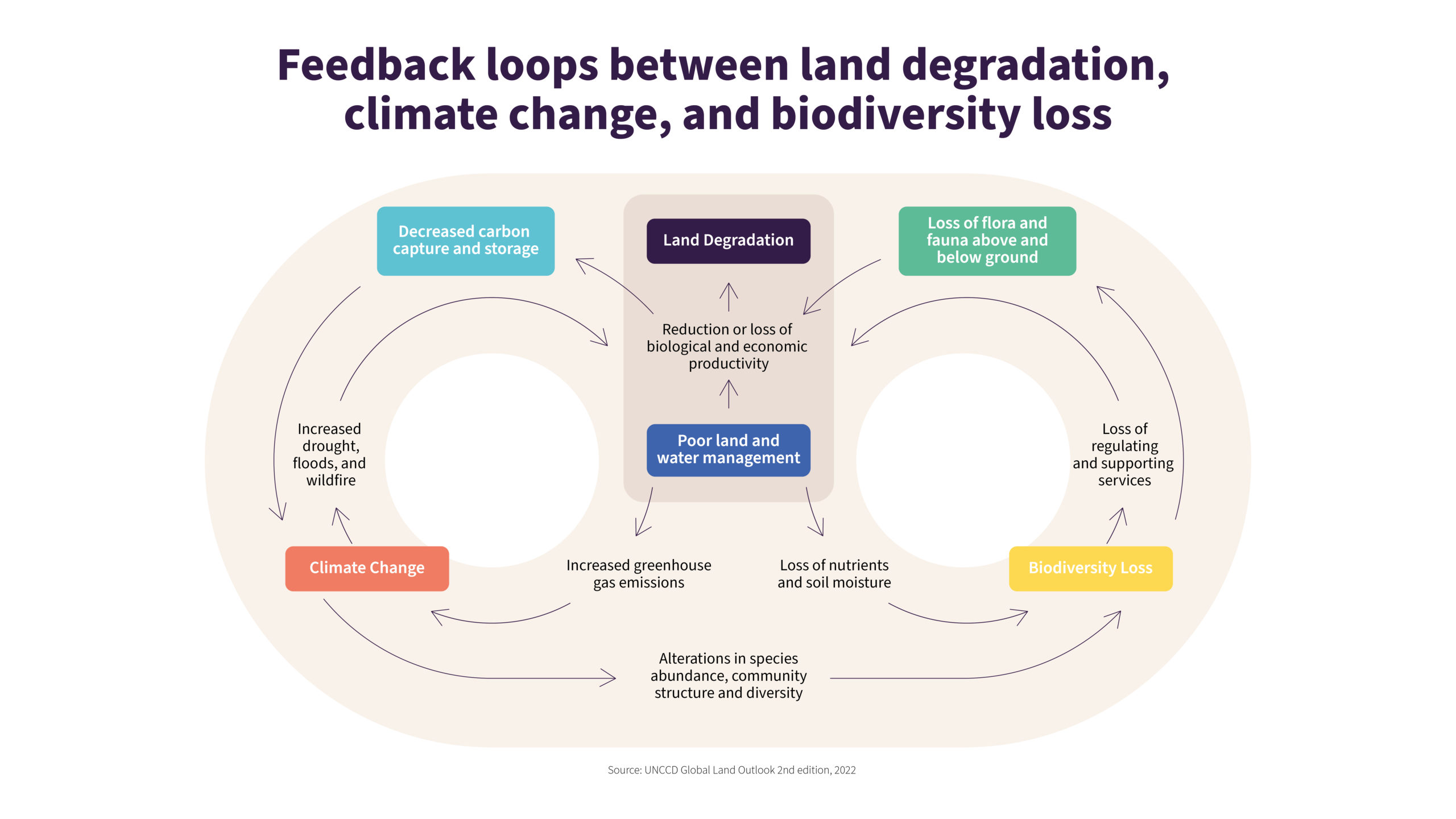In brief:
- Businesses need productive land, yet human activities and climate change are causing unprecedented levels of land degradation and drought, compromising land’s ability to support crops, livestock and wildlife and provide the valuable ecosystem services businesses rely on.
- Land degradation spells disaster for companies across industries and stages of the value chain, putting their economic value on the line. US$20 trillion worth of ecosystem services are lost each year because of land-use change and US$11 trillion from land degradation.
- Land degradation and desertification create physical, regulatory, legal, reputitional and market risks for businesses, even for those whose dependencies on land are “hidden.” If current land-use patterns continue, supply chain disruptions, loss of capital, increased operational expenses and brand damage are just some of the outcomes businesses can expect.
- Land degradation and its cascading effects on other Earth systems can also prevent businesses from making progress on biodiversity, climate and water goals.
- To lead the land-use transition, businesses must 1) assess and understand their dependencies and impacts, 2) set integrated environmental strategies, 3) work with actors across the value chain to promote sustainable land-use practices, and 4) support policy and regulatory efforts.
Often perceived as an issue primarily for desert-like regions, desertification is an invisible crisis whose grasp is more far-reaching than most companies believe and has steep consequences for business and the stability of the global economy as a whole.
Businesses need productive land.
Yet human activities (i.e., unsustainable land management practices) and climate change are causing unprecedented levels of desertification, land degradationand drought, compromising land’s ability to support crops, livestock and wildlife and provide the valuable ecosystem services humans — and businesses — rely on.
Addressing land degradation is critical for business continuity, but many organizations are going about it the wrong way.
Land degradation aggravates, and is reinforced by, other environmental challenges, including biodiversity loss, water scarcity and climate change. Many companies fail to recognize the interconnectedness of these issues and take a siloed approach to solving them.
As a cross-cutting issue, land degradation requires businesses to take an integrated planetary boundaries approach.
Below, we dig into what land degradation and desertification are, how they’re caused by and exacerbate other environmental challenges, the impact they’re having on business and how companies can take action to safeguard their futures.
Defining desertification + land degradation
Desertification refers to a type of land degradation in water-scarce areas that causes fertile land to lose biological productivity — and as a result, economic productivity. This type of degradation encompasses declines in soil quality, water resources, vegetation and a wide range of organisms (including the microorganisms responsible for soil’s ecosystem services).
Though land degradation occurs in all parts of the world, drylands, which constitute about 40% of the land on Earth and are home to 38% of the world’s population, are particularly vulnerable to land degradation because of highly variable temperatures and rainfall, low-productivity ecosystems and poor soil fertility.
Definitions
Land degradation: the reduction or loss of land’s biological or economic productivity, such as loss of biodiversity and ecosystem functions and services, due to human-caused processes
Desertification: the degradation of land in dryland areas driven by climatic variations and human activities
There areseveral key ways in which land can degrade:
- Loss of vegetation
- Salinization
- Acidification/fertility decline
- Loss of nutrients (e.g., nitrogen, phosphorus and potassium)
- Soil compaction
- Water and wind erosion
An increasingly widespread issue
Land degradation, desertification and drought are often associated with regions like sub-Saharan Africa, but they’re issues that touch all corners of the globe, including western North America, Australia, the Middle East, Central Asia and Europe (Bulgaria, Croatia, Cyprus, Greece, Hungary, Italy, Latvia, Malta, Portugal, Romania, Slovakia, Slovenia and Spain — have all indicated that they’re affected by desertification).
In total, more than 75% of the Earth’s land is already degraded, including 25-35% of drylands. By 2050, that number could jump to 90% without swift and ambitious action.
While the drivers of land degradation are local and can vary by region, land degradation and desertification have global implications. Climate change can amplify local effects and introduce new degradation via extreme events (e.g., changes in precipitation, drought, fire, etc.), but desertification and land degradation affect climate change too, disrupting the regulating and provisioning services of ecosystems through their effect onsurface moisture (and the water cycle as a whole), vegetation cover, sand and dust aerosols and GHG fluxes. As soils become drierthey’re less able to sequester carbon from the atmosphere and can actually become an et source of greenhouse gases, releasing CO2 and nitrous oxide (NO2) into the atmosphere. Drivers of degradation (e.g.,deforestation, overgrazing, wildfire, etc.) also release CO2 into the atmosphere.
Key Drivers of Impact
Human activities (unsustainable land and resource management) and climatic variations are the two main causes of land degradation and desertification.
Unsustainable land and resource management
Human activities linked to land degradation are related to unsustainable land use and resource management practices, which are often triggered by multiple underlying causes, including economic, demographic, technological, institutional and cultural pressures.
Unsustainable land use and resource management practices that degrade land
- Deforestation
- Land conversion and removal of natural vegetation cover
- Overcultivation
- Overgrazing
- Excessive use of chemical inputs (e.g., synthetic fertilizers)
- Unsustainable use of water resources (e.g., overuse and contamination)
- Poor irrigation practices
- Anthropogenic fires
- Urbanization
A key challenge for business is that many of these practices occur deep in the supply chain. Companies with multiple levels of supply and low levels of traceability may not even be aware that degradation is happening or where it’s occurring. Addressing land degradation (and its associated impacts on water, biodiversity, climate, etc.) requires companies to improve supply chain traceability to both understand what is happening upstream and to engage and collaborate with actors across the supply chain to drive change.
Climate change
Climate change magnifies the impacts of direct drivers of land degradation (e.g., soil erosion from extreme weather events, increased risk of forest fires, and changes in the distribution of invasive species, pests and pathogens) and may extend drylands at risk of desertification to other areas. These changes can aggravate social issues, such as poverty and forced migration, both of which can lead to further land degradation.
There are also feedback loops between land degradation and desertification, climate change and biodiversity loss. Changes in soil chemistry and hydrology linked to climate change-driven land degradation intensifies biodiversity loss — both above and below ground — which in turn further leads to further changes in soil fertility and erosion that favor desertification.

Tackling land degradation and desertification is a business imperative.
Land degradation spells disaster for companies across industries and stages of the value chain, putting their economic value on the line. Between 1997-2011, US$20 trillion worth of ecosystem services were lost each year because of land-use change and US$11 trillion from land degradation — an amount three times the global market value of agricultural products.
Supply chain disruptions, loss of capital and increased operational expenses are just some of the outcomes businesses can expect if current land-use patterns continue.
There are three ways in which land degradation and desertification create risks for business:
Dependencies on nature
For many industries, nature is critical for business continuity. All businesses depend, to some degree, on nature in the form of raw materials or ecosystem services. Changes in soil chemistry, fertility and hydrology linked to land degradation can affect yields, crop quality and threaten the availability and longer-term security of commodities. Lands and local conditions may become unsuitable for production. Dependencies will vary from sector to sector, with businesses that depend directly on land for resources or ecosystem services for their direct operations and supply chain being the hardest hit. However, the consequences can still be significant for companies insecondary or tertiary industries, whose dependencies are “hidden.”
- Potential impacts: closure of operations, supply chain disruption, loss of capital, increased operating costs, increased production costs, reduction or disruption in production capacity, increased insurance premiums or reduced availability of insurance for assets in high-risk locations, disruption to sales
Impacts on nature
Land degradation and desertification are creating increasing regulatory, legal, reputational and market risks for businesses. Between increasing consumer demand for sustainably produced goods, stakeholder pressure and an onslaught of regulatory changes, such as the EU Deforestation Regulation, the business imperative for taking action to reduce environmental impacts on nature are mounting.
- Potential impacts: fines and penalties, litigation, brand damage, increased compliance costs, decrease in shareholder value, reduced demand for products and services
Impacts of land degradation and desertification on society
Businesses aren’t the only ones dependent on nature for resources and ecosystem services — freshwater, clean air, stable climate and health soils are critical for society as a whole. Consequently, land degradation, and its impacts on water, biodiversity, climate, etc. can have a destabilizing effect on society, with implications for health outcomes (e.g. air pollution, food security, water quality, etc.), livelihoods, trade relations and geopolitical conflict.
- Potential impacts: disruption to workforce, conflict, gender inequity, increase in poverty, forced migration
If businesses fail to address land degradation, they’ll fail in every aspect. Yet the current level of action being taken by companies is insufficient. Many businesses don’t see how their products or operations may contribute to land degradation or, more broadly, the link between business and climate change, land degradation, biodiversity loss and water scarcity.
This lack of awareness makes it impossible to see the value of sustainable land management and the case for investing in it. The cost of inaction, however, is outweighed by the benefits of investing in efforts to reduce impacts and dependencies. According to the UN Convention to Combat Desertification, every dollar spent to restore degraded land is estimated to return between USD$7-30 in economic benefits.
It’s time for companies to look at the long-term opportunities of prioritizing sustainable land management.
Solutions
- Assess and understand dependencies and impacts, not just on land, but also water, biodiversity and ecosystem services to uncover which of their commodities have the highest environmental risks — the results might be surprising. Many companies don’t understand the link between water and ecosystem services; they understand their own land use, but not how those activities impact the water cycle or biodiversity. The Science Based Targets Network (SBTN), has released new guidance to help companies identify their key dependencies and the impact of their activities on nature and map and prioritize risks and opportunities.
- Set an integrated environmental strategy and science-based targets that address climate (including FLAG emissions), biodiversity, freshwater and land use while minimizing tradeoffs. These challenges are interconnected and can’t be addressed in silos; what affects one can affect another. Taken together, businesses can make decisions based on what’s needed and what’s effective — rather than what feels good — to accelerate progress on goals and mitigate key risks.
- Build partnerships with actors along the value chain to promote more sustainable land management practices that avoid, reduce and reverse land degradation. Businesses must eliminate incentives that promote degradation and engage with local and Indigenous communities to implement land-use transition initiatives and safeguard land rights.
- Advocate for action by supporting government policy efforts and regulations that aim to scale more sustainable business practices by requiring businesses to embed nature into decision-making.
Unsustainable land use is threatening the future of our planet, people and economy. Businesses have a responsibility and a vested interest to mitigate land degradation and lead the land-use transition.







